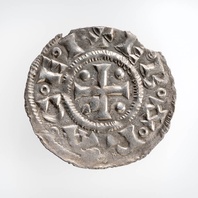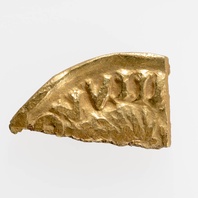
Viking Objects
Northumbrian Viking Penny (CM.952-2000)
This Sword St. Peter type silver penny is not associated with any particular ruler but was minted in the Viking kingdom of Northumbria. The coin features a sword image which is usually considered to represent the sword of St Peter, whose name features on the same side of the coin, and a hammer which is often taken to be Thor’s hammer, thus mixing the iconography of the Christian and Norse religions. It was found as part of the Thurcaston hoard which was probably buried c.923-925 CE, approximately five years after Leicester had been retaken by Mercia (c.918). The coins in the hoard are Anglo-Saxon, Arabic and Danelaw issues, showing the wide-ranging contacts between societies at this time. After the establishment of the Danelaw, some Viking leaders decided to mint their own coins to solidify their legitimacy in the eyes of the local populace. This created a hybrid economy where some members of the Danelaw used bullion and others used coins. The bullion economy resulted in some coins being cut into pieces to pay for items.
Read More

Viking Objects
Quartered Carolingian Gold Solidus (CM.163-2010)
This gold solidus of the Carolingian emperor, Louis the Pious (778-840 CE), was cut into pieces as hack-gold. Unlike the imitation gold solidus from the same era, it has not been cut carefully into quarters. Instead it has been snipped to the right size for weighing. Gold coins were used in the Carolingian empire until it adopted a silver standard.
